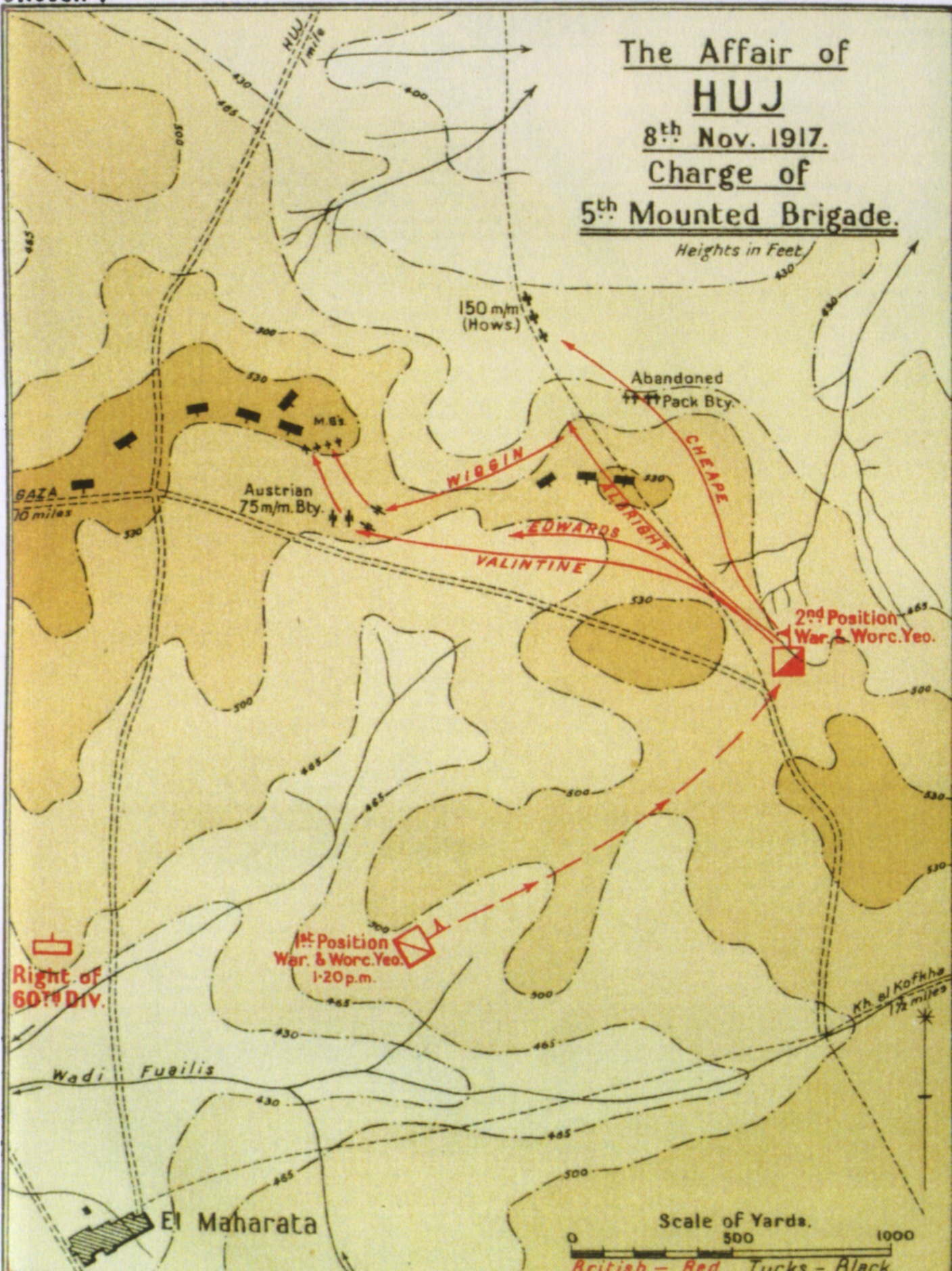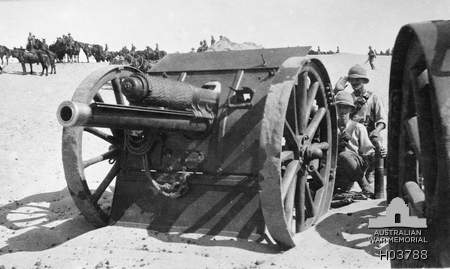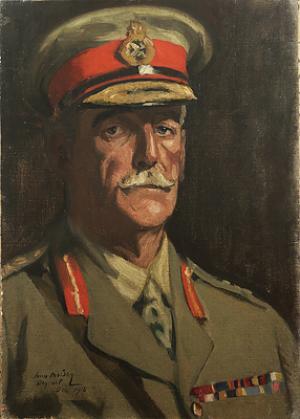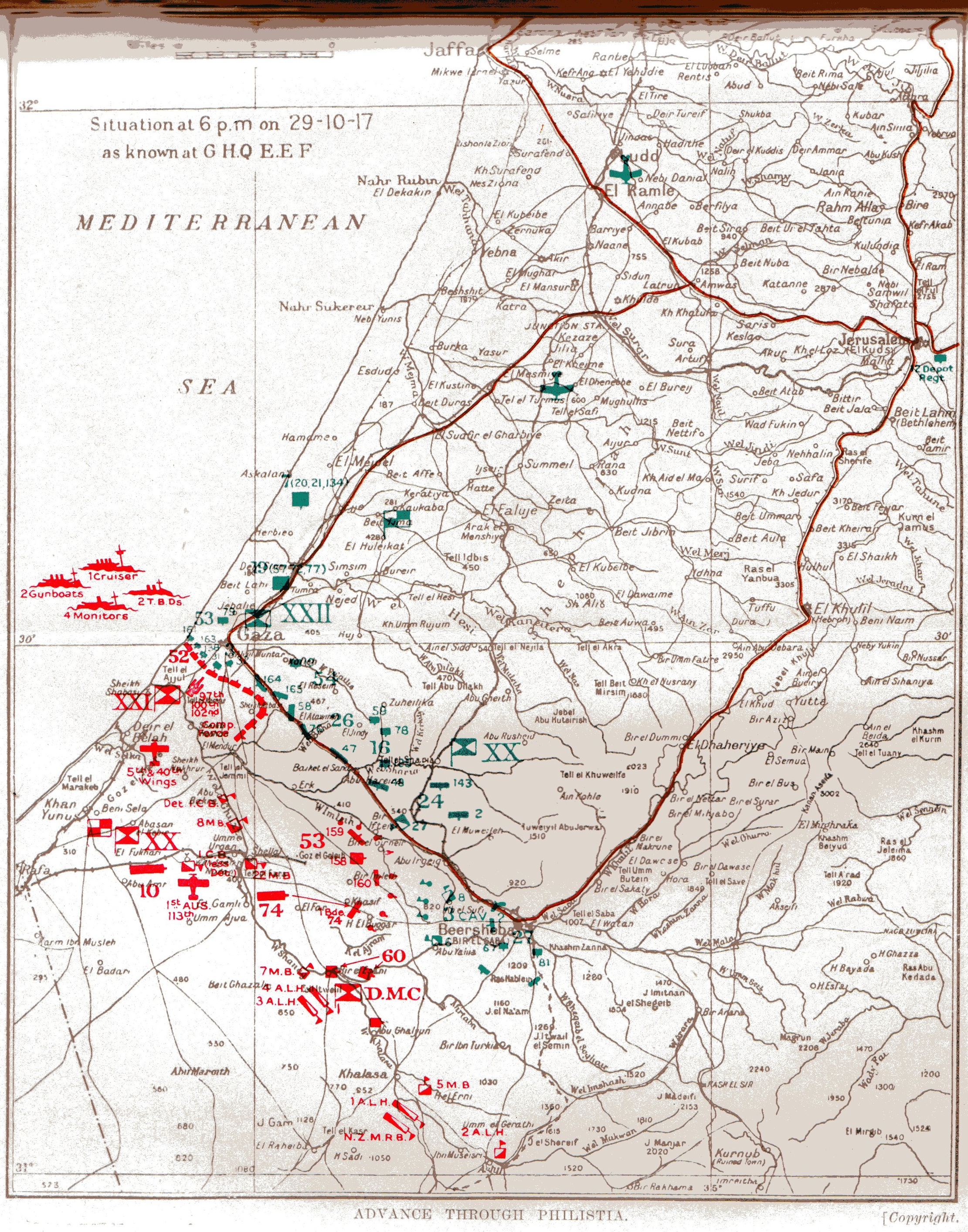|
Charge At Huj
The Charge at Huj (8 November 1917), (also known by the British as the Affair of Huj), was an engagement between forces of the British Empire' Egyptian Expeditionary Force (EEF) and the Ottoman Turkish Empire's, Yildirim Army Group during the Sinai and Palestine Campaign of the First World War. It took place during the Pursuit phase of the Southern Palestine Offensive which eventually captured Jerusalem a month later. The charge was carried out by units of the 5th Mounted Brigade, against a rearguard position of German, Austrian and Turkish artillery and infantry armed with machine guns. The charge was successful and the British captured the position, seventy prisoners, eleven pieces of artillery and four machine guns. However British casualties were heavy; of the 170 men taking part, twenty-six were killed and forty wounded. They also had 100 horses killed. The charge is claimed to be one of the last British cavalry charges and was immortalised in a watercolour painting by the ... [...More Info...] [...Related Items...] OR: [Wikipedia] [Google] [Baidu] |
Middle Eastern Theatre Of World War I
The Middle Eastern theatre of World War I saw action between 29 October 1914 and 30 October 1918. The combatants were, on one side, the Ottoman Empire (including the majority of Kurdish tribes, a relative majority of Arabs, and Caucasian ''Tatars''), with some assistance from the other Central Powers; and on the other side, the British (with the help of Jews, Greeks, Assyrians, some Kurdish tribes, and many Arabs, along with Hindu and Muslim colonial troops from India), the Russians (with the help of Armenians, Assyrians, and occasionally some Kurdish tribes) and the French (with its North African and West African Muslim colonial troops) from among the Allied Powers. There were five main campaigns: the Sinai and Palestine Campaign, the Mesopotamian Campaign, the Caucasus Campaign, the Persian Campaign, and the Gallipoli Campaign. There were also several minor campaigns: Arab Campaign, and South Arabia Campaign. Both sides used local asymmetrical forces in the r ... [...More Info...] [...Related Items...] OR: [Wikipedia] [Google] [Baidu] |
5th Mounted Brigade
The 1st South Midland Mounted Brigade (later numbered as the 5th Mounted Brigade) was a yeomanry brigade of the British Army, formed as part of the Territorial Force in 1908. It served dismounted in the Gallipoli Campaign before being remounted to serve in the Sinai and Palestine Campaign in the First World War. In April 1918, it was merged with elements of the 3rd (Ambala) Cavalry Brigade to form 13th Cavalry Brigade. It remained in Palestine after the end of the war on occupation duties. Formation Under the terms of the Territorial and Reserve Forces Act 1907 (7 Edw.7, c.9), the brigade was formed in 1908 as part of the Territorial Force. It consisted of three yeomanry regiments, a horse artillery battery and ammunition column, a transport and supply column and a field ambulance. As the name suggests, the units were drawn from the southern part of the English Midlands, predominantly Gloucestershire, Warwickshire and Worcestershire. First World War 1st South Midland ... [...More Info...] [...Related Items...] OR: [Wikipedia] [Google] [Baidu] |
Commanding Officer
The commanding officer (CO) or sometimes, if the incumbent is a general officer, commanding general (CG), is the officer in command of a military unit. The commanding officer has ultimate authority over the unit, and is usually given wide latitude to run the unit as they see fit, within the bounds of military law. In this respect, commanding officers have significant responsibilities (for example, the use of force, finances, equipment, the Geneva Conventions), duties (to higher authority, mission effectiveness, duty of care to personnel), and powers (for example, discipline and punishment of personnel within certain limits of military law). In some countries, commanding officers may be of any commissioned rank. Usually, there are more officers than command positions available, and time spent in command is generally a key aspect of promotion, so the role of commanding officer is highly valued. The commanding officer is often assisted by an executive officer (XO) or second-in-c ... [...More Info...] [...Related Items...] OR: [Wikipedia] [Google] [Baidu] |
Lieutenant
A lieutenant ( , ; abbreviated Lt., Lt, LT, Lieut and similar) is a commissioned officer rank in the armed forces of many nations. The meaning of lieutenant differs in different militaries (see comparative military ranks), but it is often subdivided into senior (first lieutenant) and junior ( second lieutenant and even third lieutenant) ranks. In navies, it is often equivalent to the army rank of captain; it may also indicate a particular post rather than a rank. The rank is also used in fire services, emergency medical services, security services and police forces. Lieutenant may also appear as part of a title used in various other organisations with a codified command structure. It often designates someone who is " second-in-command", and as such, may precede the name of the rank directly above it. For example, a "lieutenant master" is likely to be second-in-command to the "master" in an organisation using both ranks. Political uses include lieutenant governor in vari ... [...More Info...] [...Related Items...] OR: [Wikipedia] [Google] [Baidu] |
Turkish Heliograph At Huj2
Turkish may refer to: *a Turkic language spoken by the Turks * of or about Turkey ** Turkish language *** Turkish alphabet ** Turkish people, a Turkic ethnic group and nation *** Turkish citizen, a citizen of Turkey *** Turkish communities and minorities in the former Ottoman Empire * Ottoman Empire (Ottoman Turkey), 1299–1922, previously sometimes known as the Turkish Empire ** Ottoman Turkish, the Turkish language used in the Ottoman Empire * Turkish Airlines, an airline * Turkish music (style), a musical style of European composers of the Classical music era See also * * * Turk (other) * Turki (other) * Turkic (other) * Turkey (other) * Turkiye (other) * Turkish Bath (other) * Turkish population, the number of ethnic Turkish people in the world * Culture of Turkey * History of Turkey ** History of the Republic of Turkey The Republic of Turkey was created after the overthrow of Sultan Mehmet VI Vahdettin by ... [...More Info...] [...Related Items...] OR: [Wikipedia] [Google] [Baidu] |
Australian Mounted Division
The Australian Mounted Division originally formed as the Imperial Mounted Division in January 1917, was a mounted infantry, light horse and yeomanry division. The division was formed in Egypt, and along with the Anzac Mounted Division formed part of Desert Column, Egyptian Expeditionary Force in World War I. The division was originally made up of the Australian 3rd Light Horse Brigade, (formerly Anzac Mounted Division) the reconstituted 4th Light Horse Brigade, and two British yeomanry brigades; the 5th Mounted Brigade and 6th Mounted Brigade. History Formation The Imperial Mounted Division was formed in Egypt in 1917 by bringing together two Australian Light Horse brigades, two British Yeomanry brigades, and a British horse artillery brigade (four batteries). These units were: * The 3rd Light Horse Brigade was formed in Australia in October 1914 with the 8th, 9th, and 10th Light Horse Regiments and was posted to Egypt in March 1915. It was dismounted and served in G ... [...More Info...] [...Related Items...] OR: [Wikipedia] [Google] [Baidu] |
Squadron (army)
A squadron was historically a cavalry subunit, a company or battalion-sized military formation. The term is still used to refer to modern cavalry units, and is also used by other arms and services (frequently aviation, also naval). In some countries, including Italy, the name of the battalion-level cavalry unit translates as "''Squadron Group''". United States In the modern United States Army, a squadron is an armored cavalry, air cavalry, or other reconnaissance unit whose organizational role parallels that of a battalion and is commanded by a lieutenant colonel. Prior to the revisions in the US Army structure in the 1880s, US Cavalry regiments were divided into companies, and the battalion was an administrative designation used only in garrison. The reorganizations converted companies to troops and battalions to squadrons, and made squadrons tactical formations as well as administrative ones. Commonwealth In the British Army and many other Commonwealth armies, a squadr ... [...More Info...] [...Related Items...] OR: [Wikipedia] [Google] [Baidu] |
Yeomanry
Yeomanry is a designation used by a number of units or sub-units of the British Army Reserve, descended from volunteer cavalry regiments. Today, Yeomanry units serve in a variety of different military roles. History Origins In the 1790s, following the French Revolution and the rise of Napoleon Bonaparte, the perceived threat of invasion of the Kingdom of Great Britain was high. To improve the country's defences, Volunteer regiments were raised in many counties from yeomen. While the word "yeoman" in normal use meant a small farmer who owned his land, Yeomanry officers were drawn from the nobility or the landed gentry, and many of the men were the officers' tenants or had other forms of obligation to the officers. At its formation, the force was referred to as the Yeomanry Cavalry. Members of the yeomanry were not obliged to serve overseas without their individual consent. Early 19th century During the first half of the nineteenth century, Yeomanry Regiments were used exte ... [...More Info...] [...Related Items...] OR: [Wikipedia] [Google] [Baidu] |
Eighth Army (Ottoman Empire)
The Eighth Army of the Ottoman Empire ( Turkish: ''Sekizinci Ordu'') was one of the field armies of the Ottoman Army. It was established during World War I. World War I In June 1917, Enver Paşa activated the Yildirim Army Group (also known as Thunderbolt Army Group) commanded by the German General Erich von Falkenhayn, and reinforced it with surplus Ottoman units transferred from Galicia, Romania, and Thrace.Erickson ''Ordered to Die: A History of the Ottoman Army in the First World War'', Greenwood Press, 2001, , pp. 159, 171, ''Ottoman Army Effectiveness in World War I: a comparative study'' Routledge Press, 2007, p. 115 Following the formation of the Yildirim Army Group substantial forces were deployed to Syria and Palestine, where they continued to hold the Fourth Army defenses. Already in Palestine were the 3rd, 7th, 16th, and 54th Infantry Divisions while the 26th 27th, and 53rd Infantry Divisions arrived during the summer. The 3rd, 7th 16th, and 26th Infantry Division ... [...More Info...] [...Related Items...] OR: [Wikipedia] [Google] [Baidu] |
60th (2/2nd London) Division
The 60th (2/2nd London) Division was an infantry division of the British Army raised during the First World War. It was the second line-formation of the 47th (1/2nd London) Division, and was the second of two such Territorial Force divisions formed from the surplus of London recruits in 1914. The divisional insignia was a bee. Role At first the division, headquartered at Sutton Veny, Wiltshire, merely supplied the first-line Territorial divisions with drafts to replace losses through casualties. In late 1915 the division began to be equipped for field operations although it was not sent to France until July 1916, after 88 trains had conveyed the men to Southampton from camps around Warminster, Heytesbury, and Codford stations. Its engagements included the Third Battle of Gaza, the Battle of Beersheba (1917), the Battle of Jerusalem (1917), the Second Transjordan attack on Shunet Nimrin and Es Salt (1918), the Battle of Megiddo (1918), the Battle of Sharon (1918), and the ... [...More Info...] [...Related Items...] OR: [Wikipedia] [Google] [Baidu] |
Third Battle Of Gaza
The Third Battle of Gaza was fought on the night of 1–2 November 1917 between British and Ottoman forces during the Sinai and Palestine Campaign of World War I and came after the British Egyptian Expeditionary Force (EEF) victory at the Battle of Beersheba had ended the Stalemate in Southern Palestine. The fighting occurred at the beginning of the Southern Palestine Offensive, and, together with attacks on Hareira and Sheria on 6–7 November and the continuing Battle of Tel el Khuweilfe, which had been launched by General Edmund Allenby on 1 November, it eventually broke the Gaza-to-Beersheba line defended by the Yildirim Army Group. Despite having held this line since March 1917, the Ottoman Army was forced to evacuate Gaza and Tel el Khuweilfe during the night of 6–7 November. Only Sheria held out for most of the 7 November before it too was captured.The several battles fought for the Gaza to Beersheba line between 31 October and 7 November were all assigned the ti ... [...More Info...] [...Related Items...] OR: [Wikipedia] [Google] [Baidu] |






